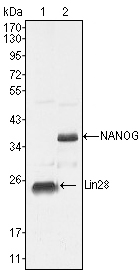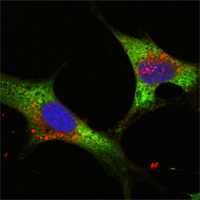LIN-28 Monoclonal Antibody
- Catalog No.:YM0416
- Applications:WB;IF;ELISA
- Reactivity:Human
- Target:
- LIN28A
- Gene Name:
- LIN28A
- Protein Name:
- Protein lin-28 homolog A
- Human Gene Id:
- 79727
- Human Swiss Prot No:
- Q9H9Z2
- Mouse Swiss Prot No:
- Q8K3Y3
- Immunogen:
- Purified recombinant fragment of LIN-28 (aa93-209) expressed in E. Coli.
- Specificity:
- LIN-28 Monoclonal Antibody detects endogenous levels of LIN-28 protein.
- Formulation:
- Liquid in PBS containing 50% glycerol, 0.5% BSA and 0.02% sodium azide.
- Source:
- Monoclonal, Mouse
- Dilution:
- WB 1:500 - 1:2000. IF 1:200 - 1:1000. ELISA: 1:10000. Not yet tested in other applications.
- Purification:
- Affinity purification
- Concentration:
- 1 mg/ml
- Storage Stability:
- -15°C to -25°C/1 year(Do not lower than -25°C)
- Other Name:
- LIN28A;CSDD1;LIN28;ZCCHC1;Protein lin-28 homolog A;Lin-28A;Zinc finger CCHC domain-containing protein 1
- Molecular Weight(Da):
- 23kD
- References:
- 1. Dev Dyn. 2005 Feb;232(2):487-97.
2. Mol Cell Biol. 2005 Nov;25(21):9198-208.
- Background:
- This gene encodes a LIN-28 family RNA-binding protein that acts as a posttranscriptional regulator of genes involved in developmental timing and self-renewal in embryonic stem cells. The encoded protein functions through direct interaction with target mRNAs and by disrupting the maturation of certain miRNAs involved in embryonic development. This protein prevents the terminal processing of the LET7 family of microRNAs which are major regulators of cellular growth and differentiation. Aberrant expression of this gene is associated with cancer progression in multiple tissues. [provided by RefSeq, Sep 2015],
- Function:
- developmental stage:Expressed in fetal liver. Expression decreases during differentiation of ES cells or upon induction of neuronal differentiation by retinoic acid.,domain:The CSD domain is required for function in muscle differentiation.,function:Acts as a 'translational enhancer', driving specific mRNAs to polysomes and thus increasing the efficiency of protein synthesis. Its association with the translational machinery and target mRNAs results in an increased number of initiation events per molecule of mRNA and, indirectly, in stabilizing the mRNAs. Binds IGF2 mRNA, MYOD1 mRNA, ARBP/36B4 ribosomal protein mRNA and its own mRNA. Essential for skeletal muscle differentiation program through the translational up-regulation of IGF2 expression.,induction:Can be negatively regulated by the interaction of microRNAs miR-125a and miR-125b with at least two miRNA responsive elements (miREs) in
- Subcellular Location:
- Cytoplasm . Rough endoplasmic reticulum . Cytoplasm, P-body . Cytoplasm, Stress granule . Nucleus, nucleolus . Predominantly cytoplasmic (PubMed:22118463). In the cytoplasm, localizes to peri-endoplasmic reticulum regions and detected in the microsomal fraction derived from rough endoplasmic reticulum (RER) following subcellular fractionation. May be bound to the cytosolic surface of RER on which ER-associated mRNAs are translated (By similarity). Shuttle from the nucleus to the cytoplasm requires RNA-binding (PubMed:17617744). Nucleolar localization is observed in 10-15% of the nuclei in differentiated myotubes (By similarity). .
- Expression:
- Expressed in embryonic stem cells, placenta and testis. Tends to be up-regulated in HER2-overexpressing breast tumors.
- June 19-2018
- WESTERN IMMUNOBLOTTING PROTOCOL
- June 19-2018
- IMMUNOHISTOCHEMISTRY-PARAFFIN PROTOCOL
- June 19-2018
- IMMUNOFLUORESCENCE PROTOCOL
- September 08-2020
- FLOW-CYTOMEYRT-PROTOCOL
- May 20-2022
- Cell-Based ELISA│解您多样本WB检测之困扰
- July 13-2018
- CELL-BASED-ELISA-PROTOCOL-FOR-ACETYL-PROTEIN
- July 13-2018
- CELL-BASED-ELISA-PROTOCOL-FOR-PHOSPHO-PROTEIN
- July 13-2018
- Antibody-FAQs
- Products Images

- Western Blot analysis using LIN-28 Monoclonal Antibody against NTERA-2 cell lysate (1).

- Confocal immunofluorescence analysis of NTERA-2 cells using LIN-28 Monoclonal Antibody (green). Blue: DRAQ5 fluorescent DNA dye.



